Stock Markets Bounce on U.S. NFP Unemployment Data
Stock-Markets / Financial Markets 2009 Sep 05, 2009 - 01:32 AM GMT Employment Situation is less than meets the eye. - Nonfarm payroll employment continued to decline in August (-216,000), and the unemployment rate rose to 9.7 percent, the U.S. Bureau of Labor Statistics reported today. Although job losses continued in many of the major industry sectors in August, the declines have moderated in recent months.
Employment Situation is less than meets the eye. - Nonfarm payroll employment continued to decline in August (-216,000), and the unemployment rate rose to 9.7 percent, the U.S. Bureau of Labor Statistics reported today. Although job losses continued in many of the major industry sectors in August, the declines have moderated in recent months.
Benjamin Disraeli once said, “There are lies, damn lies and statistics.” Let’s see how these statistics were massaged to get a happy result. First, the Household Survey Data showed that unemployment increased by 466,000 in August. Next, a look at the CES Birth/Death Model shows another 118,000 “hypothetical” new jobs. Finally, if you look at, “ Total unemployed, plus all marginally attached workers, plus total employed part time for economic reasons, as a percent of the civilian labor force, the total unemployed number is…16.8%.
So, what is the real number of unemployed? 334,000? Or 466,000?? Will we ever know?
Citi gets no pity.
The head of the committee overseeing how Uncle Sam is spending its bailout dollars offered withering criticism of the feds' handling of Citigroup's rescue, blasting regulators for their lack of transparency -- and the absence of any clear exit strategy.
Noting that other companies that have received federal aid have served up proposals to pay back the money, Elizabeth Warren, chairman of the Congressional Oversight Panel, had harsh words about the lack of such a plan in the case of Citi, which has received $45 billion in rescue cash. Citi is more than one-third owned by US taxpayers.
Are the markets in a “sweet spot?” Really???
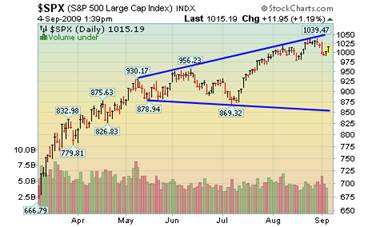 --U.S. stocks gained for a second day, paring a weekly decline for the Standard & Poor’s 500 Index, as the pace of job losses slowed and the earnings outlook for technology companies improved. Policy makers are signaling they plan to leave emergency stimulus in place even as the global recession ends, delivering what Credit Suisse Group AG and Bank of America call a “sweet spot” for financial markets.
--U.S. stocks gained for a second day, paring a weekly decline for the Standard & Poor’s 500 Index, as the pace of job losses slowed and the earnings outlook for technology companies improved. Policy makers are signaling they plan to leave emergency stimulus in place even as the global recession ends, delivering what Credit Suisse Group AG and Bank of America call a “sweet spot” for financial markets.
A contracting CPI may be good for bonds.
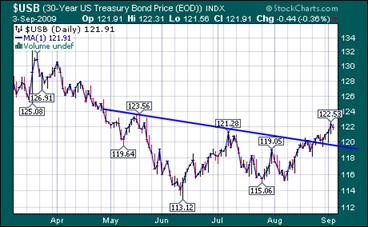 -- Treasuries were heading for a weekly gain before a Labor Department report that economists predict will show the U.S. lost jobs for a 20th month in August. Ten-year notes have climbed for four weeks as investors bet rising unemployment will curb inflation, helping to preserve the value of the fixed payments on debt. Technically, treasuries may maintain gains because of a head and shoulders pattern that implies a further rise.
-- Treasuries were heading for a weekly gain before a Labor Department report that economists predict will show the U.S. lost jobs for a 20th month in August. Ten-year notes have climbed for four weeks as investors bet rising unemployment will curb inflation, helping to preserve the value of the fixed payments on debt. Technically, treasuries may maintain gains because of a head and shoulders pattern that implies a further rise.
Gold breaks out of a triangle.
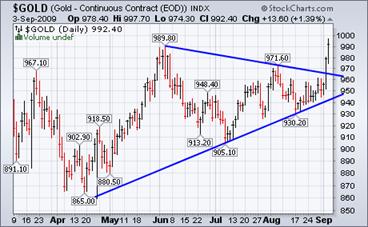 --Gold fell from a six-month high in New York as some investors locked in gains from bullion’s rally toward $1,000 an ounce and as a rebounding dollar curbed demand.
--Gold fell from a six-month high in New York as some investors locked in gains from bullion’s rally toward $1,000 an ounce and as a rebounding dollar curbed demand.
Gold futures reached $999.50 yesterday, the highest price since Feb. 23, and are heading for the biggest weekly gain since April. The rally was attributed to Asian investors seeking a safe haven.
Japanese business cut spending to the bone.
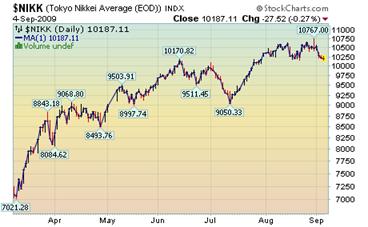 -- Japanese businesses cut spending for a ninth quarter as the global recession squeezed profits, underscoring the challenge for the incoming government to sustain a recovery from the country’s worst postwar slump. Capital spending excluding software fell 22.2% in the three months ended June 30 from a year earlier, after dropping a record 25.4% in the previous quarter, the Finance Ministry said today in Tokyo. Profits slid 53%.
-- Japanese businesses cut spending for a ninth quarter as the global recession squeezed profits, underscoring the challenge for the incoming government to sustain a recovery from the country’s worst postwar slump. Capital spending excluding software fell 22.2% in the three months ended June 30 from a year earlier, after dropping a record 25.4% in the previous quarter, the Finance Ministry said today in Tokyo. Profits slid 53%.
Will China avoid the bear market?
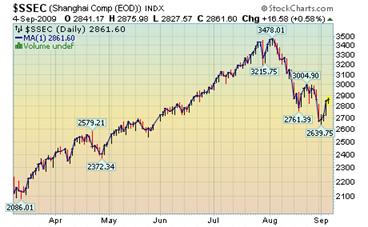
-- The Shanghai Composite Index rose the most in six months yesterday on speculation the government would refrain from measures that would slow bank credit. The gauge slumped 22 percent last month, entering a so-called bear market, on concern tighter capital requirements would curtail lending and derail a recovery in the world’s third-largest economy.
The dollar shows no gains for 3 months.
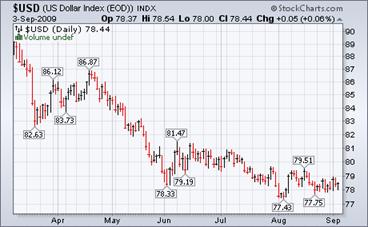 -- The dollar declined against higher- yielding currencies as stocks gained worldwide and before a report that may show U.S. payrolls dropped at the slowest pace in a year. Investor sentiment is very much against the dollar, yet it hasn’t declined (nor risen for 3 months). This trading range implies a strong move is in the offing.
-- The dollar declined against higher- yielding currencies as stocks gained worldwide and before a report that may show U.S. payrolls dropped at the slowest pace in a year. Investor sentiment is very much against the dollar, yet it hasn’t declined (nor risen for 3 months). This trading range implies a strong move is in the offing.
What not to do in a recession.
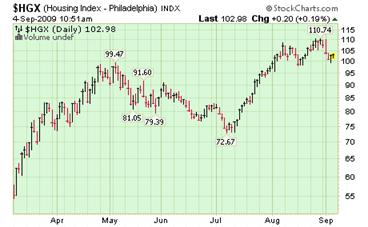 -- There are many things public officials probably shouldn't do during a severe recession, but no one seems to have told the leaders in Florida about them. One thing, for instance, would be giving a dozen top aides hefty raises while urging a rise in property taxes, as the mayor of Miami-Dade County recently did. Or jacking up already exorbitant hurricane-insurance premiums, as Florida's government-run property insurer just did. Or sending an army of highly paid lobbyists to push for a steep hike in electricity rates, as South Florida's public utility is doing. No wonder people are leaving the Sunshine State!
-- There are many things public officials probably shouldn't do during a severe recession, but no one seems to have told the leaders in Florida about them. One thing, for instance, would be giving a dozen top aides hefty raises while urging a rise in property taxes, as the mayor of Miami-Dade County recently did. Or jacking up already exorbitant hurricane-insurance premiums, as Florida's government-run property insurer just did. Or sending an army of highly paid lobbyists to push for a steep hike in electricity rates, as South Florida's public utility is doing. No wonder people are leaving the Sunshine State!
Will a weak hurricane season help gasoline prices?
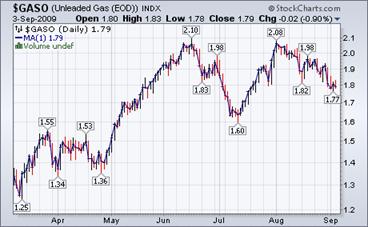 The Energy Information Administration Weekly Report suggests that, “Falling for the third straight week, the U.S. average price for regular gasoline dropped one and a half cents to settle at $2.61 per gallon. The national average was $1.07 below the year-ago price. On the East Coast, the average slipped a penny to $2.60 per gallon. The price in the Midwest dropped almost three cents to $2.52 per gallon. The average price on the Gulf Coast remained the lowest of any region, dropping nearly three cents to $2.46 per gallon.”
The Energy Information Administration Weekly Report suggests that, “Falling for the third straight week, the U.S. average price for regular gasoline dropped one and a half cents to settle at $2.61 per gallon. The national average was $1.07 below the year-ago price. On the East Coast, the average slipped a penny to $2.60 per gallon. The price in the Midwest dropped almost three cents to $2.52 per gallon. The average price on the Gulf Coast remained the lowest of any region, dropping nearly three cents to $2.46 per gallon.”
Natural gas prices still modest.
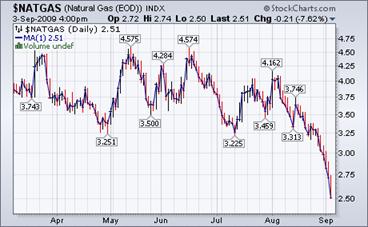 The Energy Information Agency’s Natural Gas Weekly Update reports, “Natural gas spot prices decreased on the week at all market locations, with declines of up to $0.68 per MMBtu. Dampened cooling demand in the northern parts of the lower 48 States, robust supplies of natural gas, and falling crude oil prices contributed to decreases in natural gas spot prices. Economic factors also likely affected natural gas spot prices. Equity markets experienced losses during the last 5 trading days, with the Dow Jones Industrial Average falling 262 points and the S&P 500 Index losing more than 33 points. In addition, the U.S. Department of Labor reported higher-than-expected number of new jobless claims at 570,000.”
The Energy Information Agency’s Natural Gas Weekly Update reports, “Natural gas spot prices decreased on the week at all market locations, with declines of up to $0.68 per MMBtu. Dampened cooling demand in the northern parts of the lower 48 States, robust supplies of natural gas, and falling crude oil prices contributed to decreases in natural gas spot prices. Economic factors also likely affected natural gas spot prices. Equity markets experienced losses during the last 5 trading days, with the Dow Jones Industrial Average falling 262 points and the S&P 500 Index losing more than 33 points. In addition, the U.S. Department of Labor reported higher-than-expected number of new jobless claims at 570,000.”
Could we survive without the Fed? The answer may surprise you.
The “Audit the Fed” act has a real chance in passing, but some supporters of the legislation, including Ron Paul, want to take it further than that by ending the Federal Reserve all together. Paul introduced a piece of follow-up legislation, entitled H.R. 833: The Federal Reserve Board Abolition Act which would wind down and eliminate the Federal Reserve over the course of the year. Currently, the act has no co-sponsors, but is gaining a lot of grass-roots support. Paul hopes that members of Congress will join his movement to end the Federal Reserve after they see the results of a full audit of the Federal Reserve. Paul also authored a book about his proposal to end the Federal Reserve, entitled “End the Fed![]() .”
.”
A look at Bernanke’s prototype.
There is something disarming about a technocrat. While it is easy to dismiss elected officials as blustering panderers, there is something comforting in the image of the specialist civil servant toiling away with industry and equanimity. We tend to imagine such an employee of the state poring over statistics as an ancient Greek priest might examine entrails, and carefully allocating resources like an Egyptian vizier allocating slaves. The technocrat seems benign, crucially important, and above the fray. Or is he?
Our Investment Advisor Registration is on the Web
We are in the process of updating our website at www.thepracticalinvestor.com to have more information on our services. Log on and click on Advisor Registration to get more details.
If you are a client or wish to become one, please make an appointment to discuss our investment strategies by calling Connie or Tony at (517) 699-1554, ext 10 or 11. Or e-mail us at tpi@thepracticalinvestor.com .
Anthony M. Cherniawski,
President and CIO
http://www.thepracticalinvestor.com
As a State Registered Investment Advisor, The Practical Investor (TPI) manages private client investment portfolios using a proprietary investment strategy created by Chief Investment Officer Tony Cherniawski. Throughout 2000-01, when many investors felt the pain of double digit market losses, TPI successfully navigated the choppy investment waters, creating a profit for our private investment clients. With a focus on preserving assets and capitalizing on opportunities, TPI clients benefited greatly from the TPI strategies, allowing them to stay on track with their life goals
Disclaimer: The content in this article is written for educational and informational purposes only. There is no offer or recommendation to buy or sell any security and no information contained here should be interpreted or construed as investment advice. Do you own due diligence as the information in this article is the opinion of Anthony M. Cherniawski and subject to change without notice.
Anthony M. Cherniawski Archive |
© 2005-2022 http://www.MarketOracle.co.uk - The Market Oracle is a FREE Daily Financial Markets Analysis & Forecasting online publication.



